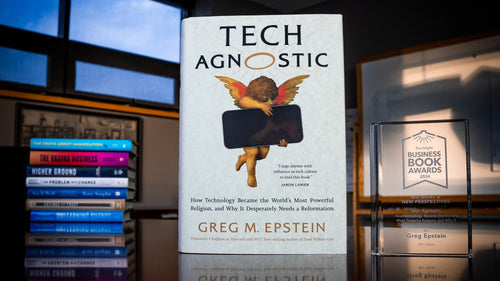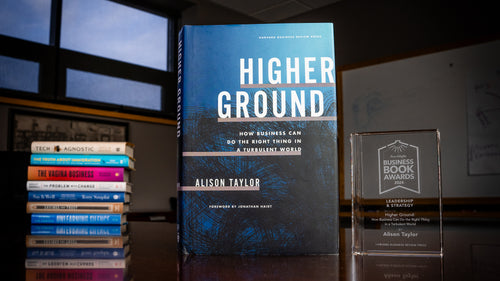An Excerpt from Your Stone Age Brain in the Screen Age
 The human brain remains largely structured like that of our Stone Age ancestors, yet we experience unprecedented and constant mental stimulation every day due to digital devices and the growing prevalence of online connectivity. In his new book, Your Stone Age Brain in the Screen Age, neurologist Richard Cytowic discusses our natural susceptibility to overstimulation and outlines the essential steps we need to take to resist it and reclaim our peace of mind.
The human brain remains largely structured like that of our Stone Age ancestors, yet we experience unprecedented and constant mental stimulation every day due to digital devices and the growing prevalence of online connectivity. In his new book, Your Stone Age Brain in the Screen Age, neurologist Richard Cytowic discusses our natural susceptibility to overstimulation and outlines the essential steps we need to take to resist it and reclaim our peace of mind.
In this excerpt from Chapter 6, Cytowic emphasizes the importance of silence, likening it to one of the essential nutrients required for sustaining human life.
◊◊◊◊◊
Silence Is an Essential Nutrient
The human body cannot produce all the nutrients it needs to function. A nutrient is therefore “essential” if it must come from outside the body—in most cases from the diet, with one exception. Micronutrients, which a person needs in small doses, include vitamins and minerals such as folic acid, B12, thiamine, and iron. A deficiency here can lead to illnesses such as anemia, scurvy, pellagra, or rickets. Macronutrients must be ingested in larger amounts; these include water, protein, carbohydrates, and fats. Essential fatty acids are omega-3 and linoleic acids, without which we can’t survive. Every cell in the body also needs protein to function properly. Of the twenty amino acids humans use to synthesize hormones and neurotransmitters, nine are indispensable and must come from an outside dietary source. The one exception is sunlight, which meets the requirements for an essential nutrient. Without it, the skin, our largest organ, could not synthesize vitamin D. More important, without the daily cycle of light and dark our circadian clocks could never reset and our sleep-wake cycles would lapse into free-fall chaos.
I consider silence another nutrient essential to health and well-being. It is remarkable how much people obsess over what foods they put in their bodies: organic, non-GMO, vegan, gluten-free, lactose-free, sugar-free, no artificial coloring, and so on. But why aren’t they as picky about what they ingest through the senses? Mental garbage we take in is arguably more harmful than an occasional cheeseburger.
Some individuals fast for health reasons or as part of religious observance, while others fast to sharpen their awareness. What if it were possible to indulge in a sensory fast for a day or even an hour, free from texts, tweets, videos, emails, and other forms of digital junk food? We might call it a caesura, to borrow the term for a quiet pause in a musical composition or a line of poetry. In vocal scores, a caesura allows singers to catch their breath—an apt metaphor for the digital maelstrom we live in.
It has become impossible to find a quiet seat in a waiting room, a doctor’s office, or an airport lounge without televisions and piped-in music assailing us. High-definition screens spew out visual noise, beckoning us to turn from whatever we are doing and LOOK HERE. You may believe, as the Borg of Star Trek insist, that “resistance is futile,” but sometimes you must shut out the world in order to open your mind. The Borg are a collective race, a partly organic, partly cybernetic hive mind whose singular purpose is to subdue species, expropriate their technology, and thereby “raise the quality of life” of the civilizations they forcibly “assimilate” (It sounds a bit like Mark Zuckerberg’s insistence on making us all “more connected”). Borg units are never aware of themselves as individuals, only as part of a collective conscious. Each unit hears the constant drone of the hive and cannot disengage from it. The hive mind is the ultimate in crowd sourcing: always “on,” always connected, always engaged in real time. The Borg represent the modern fear that technology may overtake humanity, and my Star Trek example is a representation of the way screen media infect us right now. Universities such as Duke, Georgetown, and Syracuse teach Star Trek–related courses in genetics, evolution, philosophy, and social media. As far as I know, none addresses the challenge of being able to disconnect. In A World without Email, Georgetown professor Cal Newport calls the hive mind a workflow centered on unstructured and unscheduled digital messages. He suggests regular office hours as a solution and advises students to obsess over quality rather than quantity.
Silence has become the ultimate luxury. After Washington Post columnist Richard Cohen cut his cable TV, he reminisced about a time when “an ordinary American could close the door and keep the world at bay.” Now, “only the offline can be serene. The world comes elbowing in every time you go online.” If you want to escape the commotion you must pay to join exclusive airport clubs or VIP sections. Or at least shell out for a pair of noise-canceling headphones. It is silence rather than constant badgering that gives a person room to think. Our Stone Age brain evolved over eons hearing only the sounds of nature and often, for long stretches, nothing else at all. You have only to walk in the woods, stand on a beach or in the shade of a tree, to appreciate how restorative natural quiet can be.
From a psychological point of view, silence is more than the absence of sound. It is a singular mental space. But listening to your inner self is impossible when newsfeeds, notifications, and the infinite scroll constantly address you and hold you hostage. Rather than fearing silence as emptiness—which many people dread—you can shift perspective to see it as an essential nutrient brimming with possibility. There is a reason why yoga and meditation aim to distance body and mind from the everyday buzz: a caesura is good for your neurological health and mental well-being. One meditation aid is a kōan. A famous kōan goes, “Two hands brought together make a sound. What is the sound of one hand clapping?” The more your intellect tries to solve it, the farther it pushes an answer away. Sōtō Zen, the Serene Reflection School of Buddhism, says, “Just sitting is the essence of pure Zen.” Just sitting with eyes open, trying neither to think nor not to think (closing the eyes invites daydreaming), is the natural kind of silence that constitutes an essential nutrient.
Excerpted from Your Stone Age Brain in the Screen Age: Coping with Digital Distraction and Sensory Overload by Richard E. Cytowic, published by The MIT Press. Copyright © 2024 by Richard E. Cytowic.



